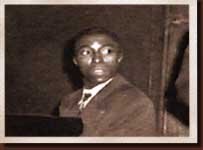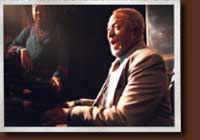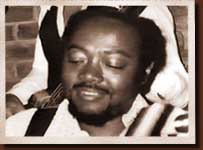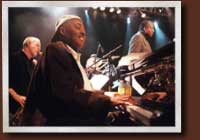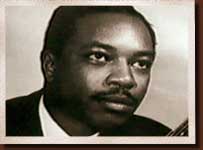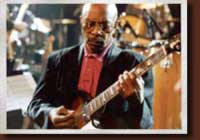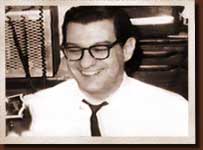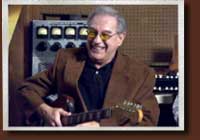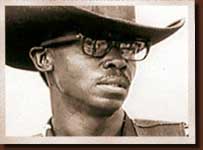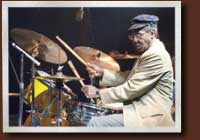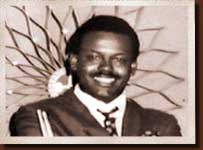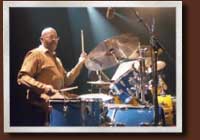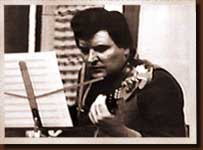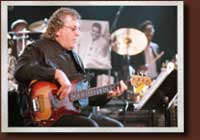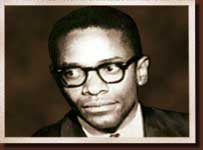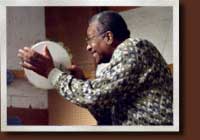|
|
Bios of
the Funk Brothers
KEYBOARDISTS
|
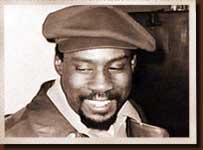 |
Earl
Van Dyke - A veteran of the late '50s
and early '60s Chitlin' Circuit, Earl migrated to
Motown in late 1962 after having toured with Aretha
Franklin and Lloyd ("Mr. Personality")
Price. Within no time, the musical sophistication
and aggressive keyboard style he brought with him
made Earl an integral part of "The Motown Sound." Hitsville's
Steinway often had to be reconditioned after Earl
played on a session because of the passion and force
with which he attacked the keys.
|
|
Arrangers
and producers looked upon him as a hub through which
they could convey their ideas to Hitsville's studio musicians.
Motown's management viewed him as the unofficial bandleader
because - apart from his talent as a keyboardist - he
always knew where to find the Funk Brothers and get them
into the studio. This was no small feat when trying to
control James Jamerson, Benny Benjamin and some of the
Funk Brothers' other more "colorful" personalities.
When Motown's "Golden Era" ended in Detroit,
Earl hooked up with Freda ("Band Of Gold")
Payne and toured the world with her throughout the remaining
years of the 1970s before returning home to teach music
in the Detroit public school system.
Born:
Detroit, MI in the early 1930s (died 1992)
Nicknames:
Chunk Of Funk, Ookie, Big Funk
Musical
Influences: Tommy Flanagan, Hank Jones, Barry Harris
Instruments
Played: : Steinway grand piano, Hammond B-3 organ, Wurlitzer
electric piano, Fender Rhodes, toy piano
Greatest
Performances: "Ain't Too Proud To Beg," "My
Guy," "For Once In My Life"
|
|
|
Joe
Hunter - Motown's first bandleader, Joe
left Hank Ballard and the Midnighters to join Berry
Gordy's fledgling recording operation in 1958. A
self-described "boogie-woogie" piano player,
Joe's keyboard style set the "down home," rootsy
feel on most of the company's early twist, doo-wop,
and blues influenced recordings. During this period
of musical simplicity and small orchestrations, Joe's
arranging talents often came into play during the
recording sessions.
One
of his favorite and most painful memories was playing
on the ill-fated "Way Over There" session for
the Miracles in which an engineer accidentally erased
the tape after Berry Gordy had made the studio musicians
take the song thirty-two times. Gone from the company
by the end of 1963, Joe's influence nevertheless continued
to resound throughout Motown's Detroit era in the musical
tone he set, and in the cornerstone musicians he helped
Berry Gordy recruit during the label's early days. Currently
in his mid-'70s, Joe still performs on a full-time basis
throughout the Detroit metropolitan area.
Born:
Jackson, Tennessee in 1927
Nicknames:
None
Musical
Influences: Art Tatum, Sergei Rachmaninov, Nat King Cole
Instruments
Played: Steinway grand piano, Hammond B-3 organ
Greatest
Performances: "Heat Wave," Pride And Joy," "Come
And Get These Memories"
|
|
|
|
|
Johnny
Griffith - One of the few classically
trained musicians in the Funk Brothers ranks, Johnny
was Hitsville's "hired gun," having never
signed the exclusive recording contract under which
most of Motown's rhythm section musicians worked.
Originally lured into the company in 1961 hoping
to record jazz, Johnny often moonlighted on hits
for other R&B record labels around Detroit and
in Chicago.
While
he did get the opportunity to record two albums on Motown's "Workshop
Jazz" label, his true value down in "Studio "A" was
in the delicate touch with which he played that so perfectly
complimented Earl Van Dyke's "gorilla piano" style.
This two keyboard approach had Earl and Johnny spending
the next decade trading off on acoustic piano, Hammond
organ, and Wurlitzer electric piano. To this day, in
spite of all the R&B hits Johnny played on, he still
considers himself, first and foremost, a jazz musician.
Born:
Detroit, MI (died 2002 in Detroit)
Nicknames:
None
Musical
Influences: Bud Powell, Glenn Gould, Oscar Peterson
Instruments
Played: : Steinway grand piano, Hammond B-3 organ, Wurlitzer
electric piano, celeste, harpsichord, Fender Rhodes
Greatest
Performances: "Wonderful One," "Stop In
The Name Of Love," "I Heard It Through The
Grapevine" (Marvin Gaye Version)
|
|
GUITARISTS
|
|
Eddie
Willis - Detroit may have been a northern
city but the Motown Sound had a lot of the South
in it. One of the principal reasons was the Mississippi
funk that Eddie Willis brought to Studio "A." After
playing guitar in Marv Johnson's band (Motown's first
star and the singer of "Come To Me"), Eddie
became an integral part of the label's recording
operation in 1959. Unlike most of the Funk Brothers
who were jazz musicians, Eddie came from more of
a country and blues background.
His
principal duty in the guitar triumvirate of Messina,
White, and Willis was to add the spontaneous funky fills
and rhythms that played off of the more foundation oriented
parts the other two guitarists were usually laying down.
Eddie was also a more active road musician than most
of the Funk Brothers, touring with the Marvelettes during
Motown's early days and later spending almost two decades
playing throughout the world with the Four Tops following
the label's 1972 departure from Detroit. While Eddie
actively recorded at Hitsville until the operation closed
down, a lot of his most prolific work was on the early
Mary Wells and Marvelettes sessions.
Born:
Grenada, Mississippi in 1936
Nicknames:
Chank, Soupbone
Musical
Influences: Chet Atkins, Wes Montgomery, Albert King
Instruments
Played: Early '60s Gibson Firebird, mid-'60s Gibson ES
335, Coral Sitar
Greatest
Performances: "I Was Made To Love Her," "The
Way You Do The Things You Do," "Friendship
Train"
|
|
|
|
|
Joe
Messina - One of
the signature musical elements that set Motown apart
from all the other recordings that rode the radio
waves in the 1960's was the razor-sharp guitar backbeats
heard on almost every recording they released. That
role was played flawlessly by Joe Messina, a local
Detroit jazz guitarist with a sense of time that
could be used to set the world clock in Greenwich,
England. Earl Van Dyke insisted that "Joe never
blew a backbeat on one session during the entire
fourteen years he was at Motown." He also had
the challenging role of doubling James Jamerson's
bass lines on numerous recordings.
Joe
arrived at Motown in 1959 and came back to it four decades
later by very circuitous routes. Playing mostly Italian
music in his teens, the lure of jazz was overpowering
and by his mid twenties, he had landed a gig on the nationally
televised Soupy Sales Show. That afforded him the opportunity
of playing with John Coltrane, Charlie Parker, Miles
Davis and all of his other jazz heroes who were guest
artists on the show. Because of his growing reputation
around town, Berry Gordy recruited him. When Motown moved
to the West Coast in 1972, Joe put down his guitar for
almost thirty years, but he quickly got his chops back
in late 2000 to play on Standing In The Shadows Of Motown.
Born:
Detroit, MI in 1928
Nicknames:
None
Musical
Influences: Charlie Parker, Les Paul, George Barnes
Instruments
Played: Gibson L-5 (in the early days only), an early
'60s Fender Telecaster with a Jazzmaster neck strung
with heavy flatwound strings.
Greatest
Performances: "Your Precious Love.," "Dancing
In The Street," "I Can't Help Myself"
|
|
|
Robert
White - One of the more serious-minded
and deep thinkers amongst the members of the Funk
Brothers, Robert is often referred to by his fellow
Hitsville musicians as "the glue that held everything
together." What they're referring to is the
fat, relaxed guitar strums he played that were the
meeting point for all the inter-twined parts everyone
else was laying down. Robert was also called upon
any time the producers and arrangers needed a very
distinct melody to be played on guitar, because he
picked his instrument with a long thumbnail that
gave all his lines a very unique and instantly recognizable
tone.
|
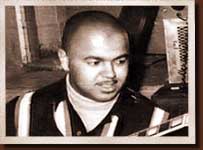 |
|
Arriving
in Detroit in 1960 when the doo-wop group the Moonglows
(for whom he was playing bass) ended a tour, Robert began
working for Motown and quickly became a favorite of the
producers and arrangers. Like Uriel Jones, he teamed
up with Earl Van Dyke and became a fixture on Detroit's
nightly club scene. Always in search of some higher meaning
for his life, Robert moved to Los Angeles in the mid-'70s
hoping to continue his musical career and continue his
spiritual quest. While he never again reached the musical
heights he had enjoyed back in Detroit, he found what
he was looking for in his personal life through Eckankar
(The Religion of The Light And Sound Of God).
Born:
Billmyre, Pennsylvania in 1936 (died 1994 in Los Angeles)
Nicknames:
Robert had one but he hated it
Musical
Influences: Oscar Moore (Nat King Cole's guitarist),
Wes Montgomery
Instruments
Played: Gibson ES 335, Gibson L-5
Greatest
Performances: "My Girl," "My Cherie Amour," "You
Keep Me Hanging On"
|
|
| DRUMMERS |
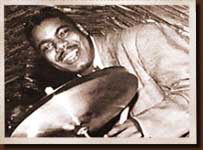 |
William "Benny" Benjamin -
The creator of the Motown drumbeat and the most beloved
musician at Hitsville, Benny was Motown's first drummer,
working with Berry Gordy in 1958. Known for his deft
brushwork, latin-influenced grooves, and his explosive
drum fills and pickups, Benny's signature drum style
defined the Motown groove. Coming out of a big band-jazz
background, Benny's beats swung much harder than any
of the other R&B and Blues drummers residing in Detroit
at the time, and his time was impeccable.
|
|
But
the same couldn't be said for his promptness. Benny's
excuses for often being late to Hitsville's recording
sessions are legendary - including one where he claimed
to have been sitting on his mother's step with his ex-old
lady's boyfriend when someone pulled up in a car and
shot him. He further endeared himself to his fellow Motown
musicians when - right in front some European distributors
Berry Gordy was trying to impress with his new operation
- he asked the boss if he could "bum a fin." "The
Fuehrer," as Benny referred to him, was not pleased.
A lifelong heroin user and alcoholic, Benny's demons
eventually caught up with him in 1968 when the ravages
of his addictions stilled his drumsticks.
Born:
Birmingham, Alabama in the early 1930s (died 1968)
Nicknames:
Papa Zita
Musical
Influences: Buddy Rich, Tito Puentes
Instruments
Played: A studio set comprised of Ludwig, Slingerland,
Rogers, and Gretsch components
Greatest
Performances: "Shop Around," "Get Ready," "Going
To A Go-Go"
|
|
|
Richard "Pistol" Allen -
Noted Detroit bassist Ralphe Armstrong once related how
he was playing a gig at a local jazz club when Pistol
Allen (wearing only pajamas, a robe, and slippers) busted
through the doors of the establishment, threw the drummer
off his set, and counted off "Cherokee" at
a breakneck tempo: "Man, we were all huffin' and
puffin' trying to keep up with him for about ten choruses
of the tune and then he just cuts the band, jumps off
the stage and runs home," recalled Ralphe. "This
fool was probably just sittin' in front of his TV and
said to himself, 'I feel like playing,.' So he drives
halfway across town, gets it out of his system, and then
runs back to the TV. You see, this cat just burns with
music."
Recruited
into Motown in 1962 by his mentor, Benny Benjamin, Pistol
quickly learned he had to adapt his jazz drum style to
the music being created down in the Snakepit. Pistol
recalls, "Benny advised me, 'Jazz don't work down
there. They want it straight with 8th notes and a big
backbeat. Just play mm-mm-da, mm-mm-da and keep your
mouth shut.'" Pistol listened well. The result was
a new Motown drum style that featured a sledgehammer
backbeat with a heavy hi-hat that gave the producers
a nice variation to what Uriel Jones and Benny were doing.
The master of the Beale Street shuffle and the Motown "four
on the floor" groove (a snare drum hit on every
beat), Pistol was the drummer on most of Holland-Dozier-Holland's
hit productions of the '60s.
Born:
Memphis, Tennessee in 1932 (died 2002 in Detroit)
Nickname:
Pistol
Musical
Influences: Benny Benjamin, Max Roach, Buddy Rich
Instruments
Played: A studio set comprised of Ludwig, Slingerland,
Rogers, and Gretsch components
Greatest
Performances: "Heat Wave," "Baby Love," "How
Sweet It Is"
|
|
|
|
|
Uriel
Jones - After touring with Marvin Gaye
and various Motown road shows in the early '60s,
Uriel became a Hitsville session player in 1964.
Originally expected to be a Benny Benjamin clone
(which he mastered as much as any human possibly
could), Uriel quickly showed Motown's producers and
arrangers that he had something else to offer: he
rocked harder than any of the other drummers in the
building. Motown arranger Paul Riser explains, "Uriel's
drum sound was the most open and laid back and he
was the funkiest of the three guys we had. He had
a mixed feel and did a lot of different things well."
Uriel
was an indispensable component of producer Norman Whitfield's "psychedelic
soul" recordings with the Temptations, and Ashford
and Simpson's Marvin Gaye-Tammi Terrell duets were all
fueled by his slammin' drum grooves. Joined at the hip
with Earl Van Dyke for the next three decades, Uriel
was the main drummer when the Funk Brothers performed
at the Chit Chat club, the Twenty Grand, and the other
venues they frequented during Detroit's booming nightlife
scene of the '60s.
Born:
Detroit, MI in 1934
Nicknames:
Possum
Musical
Influences: Benny Benjamin, Art Blakey
Instruments
Played: A studio set comprised of Ludwig, Slingerland,
Rogers, and Gretsch components
Greatest
Performances: "Ain't Too Proud To Beg," "Cloud
Nine," "Ain't No
Mountain High Enough"
|
|
| BASSISTS |
|
James
Jamerson - Motown's tormented genius,
James Jamerson is unanimously acclaimed as the first
virtuoso of the electric bass. Plagued by alcoholism
and emotional problems throughout his career, James
has influenced (whether they know it or not) every
electric bassist to ever pick up the instrument.
Arriving at Motown in 1959, James' bass playing evolved
over the next decade from a traditional root-fifth
cocktail style of bass playing into an astonishing
new style built upon a flurry of sixteenth-note runs
and syncopations, "pushing the envelope" dissonances,
and fearless and constant exploration.
|
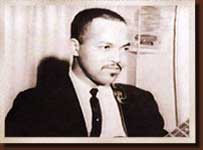 |
|
A converted
upright bass player with bear claw hands, James plucked
the strings with only the index finger of his right hand
(which he dubbed "The Hook), and effortlessly and
routinely pulled off head-turning, technical feats on
the '62 P-Bass he nicknamed "The Funk Machine." His
explosive, earthquake-heavy bass lines have had the entire
world dancing and grooving to Motown records for over
four decades. But he labored in total obscurity - a condition
that ate at him throughout the last years of his life.
Recognition finally came on March 6, 2000 when James
Jamerson was inducted posthumously into the Rock & Roll
Hall Of Fame.
Born:
Edisto Island, South Carolina in 1936 (died in Los Angeles
1983)
Nicknames:
Igor, Funk, Diego Diegerson
Musical
Influences: Ray Brown, Paul Chambers
Instruments
Played: 1957 Fender Precision, 1962 Fender Precision
(The Funk Machine), German Upright bass, Fender 5 string,
Hagstrom 8 string
Greatest
Performances: "Bernadette," "I Was Made
To Love Her," "Home Cookin'"
|
|
|
|
Bob
Babbitt - Stepping into the shoes of a
legend is an impossible burden to handle but Bob
Babbitt was tough enough to be able to work in James
Jamerson's shadow and still assert his own identity
on some of Motown's biggest hits. After freelancing
around Detroit in the mid-'60s, Bob joined Stevie
Wonder's band in 1966 and eventually was brought
into the studio in 1967. The overwhelming workload
in the wake of Motown's phenomenal success combined
with James Jamerson's increasing health problems
necessitated bringing in a second bassist.
Instantly
accepted into the Funk Brothers' family atmosphere, Bob
had a very busy six year run at Hitsville particularly
with Motown producer Norman Whitfield. The shining moment
in Bob's career came in 1970 when he worked with Marvin
Gaye on some of the tracks from his epic "What's
Going On" album. After Motown's exodus from Detroit
in 1972, Bob's busy studio career continued in New York,
Philadelphia, and in Nashville where he currently resides.
Born:
Pittsburgh, PA
Nickname:
Babbitt (birth name - Robert Kreinar)
Instrument
Played: Post-CBS, mid-'60s Fender Precision Bass
Musical
Influences: Charles Mingus, Ray Brown, James Jamerson
Greatest
Performances: "Mercy Mercy Me," "Signed,
Sealed, Delivered," "War"
|
|
| PERCUSSIONISTS |
|
Jack
Ashford - Upon hearing the early Motown
records that invaded England in the '60s, EMI Records'
president Sir Joseph Blackwood remarked they would
never make it because the tambourine was mixed too
hot.. But Sir Berry Gordy of Motown Records knew
something that Sir Joseph didn't: Jack Ashford was
not just any old tambourine player - he was a tambourine
virtuoso. Just talk to any percussionist about "the
cat that played tambourine at Motown" and watch
them become enraptured.
But
his first love was vibes, and his playing caught the
eye of Marvin Gaye when he saw Jack playing with an organ
trio in Boston. Coming to Motown at Marvin's request
in 1963, Jack went on to become their most prolific percussionist,
playing more than a dozen traditional percussion instrument
as well as a few "off the beaten track" instruments
like knee slaps, foot stomps, and his own invention,
the "hotel sheet." A particular favorite of
Marvin Gaye and Norman Whitfield, Jack's imaginative
and colorful percussion grooves were one of the principal
reasons why these two great artists always seemed to
be breaking new ground with every recording they produced.
Born:
Philadelphia, Pennsylvania in 1934
Nicknames:
None
Musical
Influences: Milt Jackson, Lionel Hampton
Instruments
Played: : Deagan model 510 and Deagan Imperial Nocturne
vibes, marimbas, tambourine, wood block, foot stomps,
hand claps, maracas, cabassa, bells, chimes, bell tree,
hotel sheet, triangle, finger cymbals, kazoo
Greatest
Performances: "What's Going On," "Ooh
Baby Baby," "Where Did Our Love Go"
|
|
|
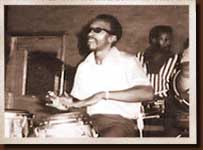 |
Eddie "Bongo" Brown -
As great a role as Eddie Bongo played musically, he was
an irreplaceable element in the Funk Brother's family
for one simple reason: In the pressure cooker atmosphere
of the Snakepit, they desperately needed a comedian to
keep things from boiling over and Eddie was a virtuoso.
A master at playing "the dozens," many a session
ground to a halt as players doubled over in laughter
while Bongo wailed on James Jamerson's mother (his favorite
target) or some other unsuspecting victim.
|
|
Coming
into Motown through the back door as Marvin Gaye's valet,
Eddie eventually became Hitsville's most prolific conga
player gracing many of the label's greatest recordings
with his latin and jazz grooves. Like some of the other
Funk Brothers, Bongo moved to the West Coast in the mid-'70s
hoping to still record for Motown while picking up recording
gigs for other labels. But his fate was the same. Bongo
found it impossible to regain the magic that he had been
a part of in Detroit.
Born:
Memphis, Tennessee in 1932 (died in Los Angeles 1983)
Nickname:
Bongo
Musical
Influences: Chano Pozo
Instruments
Played: : LP congas, bongos, gourd, claves
Greatest
Performances: "Cloud Nine," "What's Going
On," "Beauty Is Only Skin Deep"
|
|
|
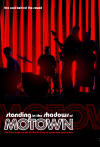
HOME
|
|


